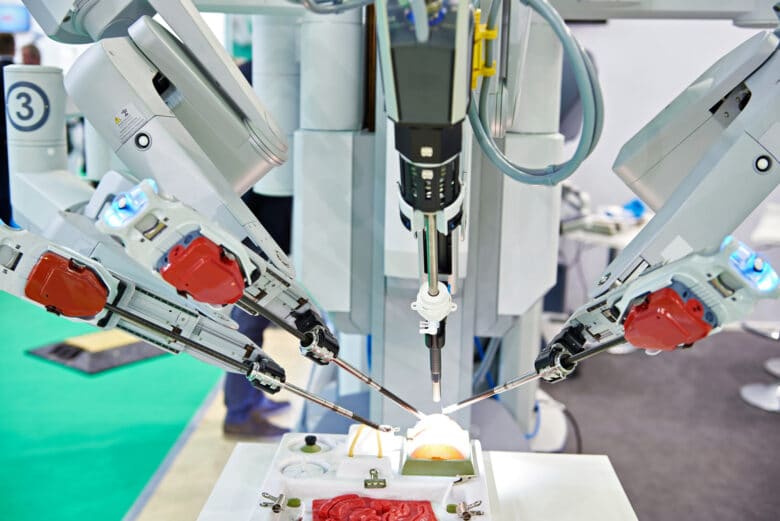
Technological progress ensures that breakthroughs in medicine can be heard year after year. Now, a research team consisting of several international scientists is apparently on the verge of the next milestone. For example, a robot specializing in surgical procedures has been able to solve a common exercise task faster than its flesh-and-blood counterpart.
Metal Surgeon
On Feb. 10, 1996, the world marveled when a computer developed by IBM defeated then-world chess champion Garry Kasparov. Since then, with many more milestones, it has become clear that machines with the right software and power are superior to humans in many ways. For example, in February, a small robot dog from Boston Dynamics was used for the first time in a major fire in the German state of Hesse to independently search for survivors in the affected house. Now it also seems to be ready in the field of surgery.
During the so-called “Peg Transfer”, an exercise for surgeons, a team of scientists was able to determine that the developed surgical robot not only worked independently as precisely as a human. On top of that, it finished its training task, which simulates a minimally invasive procedure, faster than a human surgeon. According to the scientists, the robotic system called “da Vinci” has set a new record and, at the same time, a milestone in the history of medicine. After all, no other robot has yet managed to outperform humans in surgical tasks.
Robots are not new to the operating room
Of course, the “da Vinci” type robot could not master this challenging task on the first try. Instead, the scientists relied on the principle of machine learning, which is based on the motto “practice makes perfect.” The so-called da Vinci Research Kit is not a newcomer to the field of surgery. Instead, surgeons have been using this technique for some time to assist with minimally invasive procedures. Because this surgical method relies on the smallest possible incisions, it is colloquially known as the keyhole method. Given the small incision, this surgical technique must rely on cameras that send the area to be operated on a screen.

In the context of these procedures, the da Vinci Research Kit has been acting as a robotic arm to assist the surgeon for some time now. However, the machine does not act independently, but is controlled by the surgeon. The scientists have taken advantage of this principle. They placed several markers on the robot and used them to record the motion sequences. They then used the resulting results to develop an algorithm for the independent work of the robot. Consequently, it underwent a training program that ultimately made it better than a human surgeon.
The results are truly amazing
The experimental setup promised strong competition for the surgical robot. Among the participants was a surgeon who had already completed more than 900 operations in his career. Robots and doctors alike were to perform the “peg transfer” in order to be able to draw comparisons. This exercise is a common training for young surgeons who are still in their training phase. Here, one has to maneuver tiny blocks from A to B with a lot of dexterity. The doctors do not use tweezers, but control the robotic arm. Peg Transfer is divided into three levels of varying difficulty. Level one requires the movement of the blocks with the help of a robotic arm. Level two, on the other hand, has the surgeons perform the task in parallel with two robots. In level three, the doctors are then even supposed to transfer the small blocks from one robotic arm to the other.
A new milestone in medicine
The robot came out ahead of the experienced surgeons in the disciplines requiring both arms. Only in the experimental setup, which involves moving blocks using one arm, did the flesh-and-blood surgeons claim victory. Despite its high speed, the robot performed flawlessly. According to the scientists, it had a success rate of 100 percent. However, the same also applied to its human counterpart. But what do the scientists conclude from their test setup? From their point of view, it is clear proof that robot technology can also be used for surgical interventions without humans – at least in theory. It is clear that the Peg Transfer is based on a rigid test object.
The human body, on the other hand, is anything but rigid – even when the patient is anesthetized. For this reason, they emphasized once again that comparable exercises on human test objects are still a thing of the future. After all, these involve far more complex challenges. Before they get that far, the robots will probably have to “work on animals” anyway. As a result, surgeons will by no means have to hang up their coats and fear for their jobs. It will be a long time before robots can perform operations on their own. Nevertheless, the study is a step in the right direction. After all, it showed that robots can do the job much faster. On top of that, there is no need to worry about life-threatening fatigue with them.
Is this just the beginning?
On the part of the research team, they are now motivated by one thing above all else. So they want to develop new experimental setups as quickly as possible, in which the robots can perform other medical tasks. They are thinking in particular of auxiliary tasks such as suturing wounds after surgery. Since the skin is a rigid object, the complexity of this task is also likely to be much lower. It is possible that sooner or later the first robots could also work alone in this supportive area. That technology can save human lives was demonstrated as recently as January of this year by a drone operation in Sweden. Here, a drone delivered a defibrillator in the course of an emergency call within a few minutes after a man suffered a heart attack.




No replies yet
Neue Antworten laden...
Gehört zum Inventar
Beteilige dich an der Diskussion in der Basic Tutorials Community →